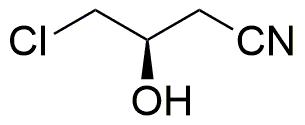(R)-(+)-4-Chloro-3-hydroxybutyronitrile is widely utilized in research focused on
- Pharmaceutical Development: This compound serves as an intermediate in the synthesis of various pharmaceuticals, particularly those targeting neurological disorders. Its unique structure allows for the creation of drugs with enhanced efficacy and reduced side effects.
- Agricultural Chemicals: It is used in the formulation of agrochemicals, helping to develop more effective herbicides and pesticides. The compound's properties can lead to improved crop yields and better pest management.
- Biochemical Research: Researchers employ this chemical in studies related to enzyme inhibition and metabolic pathways, providing insights into cellular processes and potential therapeutic targets.
- Material Science: Its application in creating specialized polymers and resins allows for the development of materials with unique properties, such as increased durability and resistance to environmental factors.
- Analytical Chemistry: The compound is utilized in various analytical techniques, including chromatography, to separate and identify complex mixtures, aiding in quality control and research analysis.
General Information
Properties
Safety and Regulations
Applications
(R)-(+)-4-Chloro-3-hydroxybutyronitrile is widely utilized in research focused on
- Pharmaceutical Development: This compound serves as an intermediate in the synthesis of various pharmaceuticals, particularly those targeting neurological disorders. Its unique structure allows for the creation of drugs with enhanced efficacy and reduced side effects.
- Agricultural Chemicals: It is used in the formulation of agrochemicals, helping to develop more effective herbicides and pesticides. The compound's properties can lead to improved crop yields and better pest management.
- Biochemical Research: Researchers employ this chemical in studies related to enzyme inhibition and metabolic pathways, providing insights into cellular processes and potential therapeutic targets.
- Material Science: Its application in creating specialized polymers and resins allows for the development of materials with unique properties, such as increased durability and resistance to environmental factors.
- Analytical Chemistry: The compound is utilized in various analytical techniques, including chromatography, to separate and identify complex mixtures, aiding in quality control and research analysis.
Documents
Safety Data Sheets (SDS)
The SDS provides comprehensive safety information on handling, storage, and disposal of the product.
Product Specification (PS)
The PS provides a comprehensive breakdown of the product’s properties, including chemical composition, physical state, purity, and storage requirements. It also details acceptable quality ranges and the product's intended applications.
Certificates of Analysis (COA)
Search for Certificates of Analysis (COA) by entering the products Lot Number. Lot and Batch Numbers can be found on a product’s label following the words ‘Lot’ or ‘Batch’.
*Catalog Number
*Lot Number
Certificates Of Origin (COO)
This COO confirms the country where the product was manufactured, and also details the materials and components used in it and whether it is derived from natural, synthetic, or other specific sources. This certificate may be required for customs, trade, and regulatory compliance.
*Catalog Number
*Lot Number
Safety Data Sheets (SDS)
The SDS provides comprehensive safety information on handling, storage, and disposal of the product.
DownloadProduct Specification (PS)
The PS provides a comprehensive breakdown of the product’s properties, including chemical composition, physical state, purity, and storage requirements. It also details acceptable quality ranges and the product's intended applications.
DownloadCertificates of Analysis (COA)
Search for Certificates of Analysis (COA) by entering the products Lot Number. Lot and Batch Numbers can be found on a product’s label following the words ‘Lot’ or ‘Batch’.
*Catalog Number
*Lot Number
Certificates Of Origin (COO)
This COO confirms the country where the product was manufactured, and also details the materials and components used in it and whether it is derived from natural, synthetic, or other specific sources. This certificate may be required for customs, trade, and regulatory compliance.

